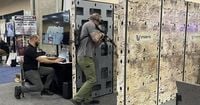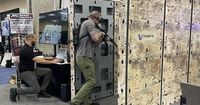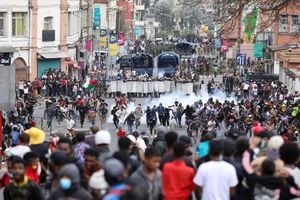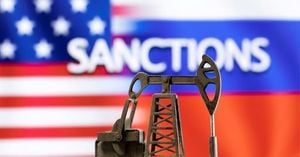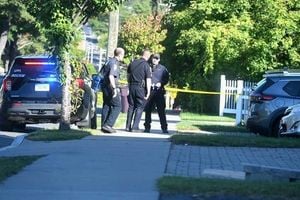On a bright Texas day in September 2025, the air outside the National School Safety Conference in Grapevine was filled with the whir of three drones circling a test dummy’s head. This wasn’t some futuristic game—it was a demonstration by Campus Guardian Angel, a company at the forefront of an industry that has exploded into a multi-billion dollar market: school shooting prevention. "We use drones to stop school shootings," explained Justin Marston, the company’s CEO. In the event of an attack, these drones, stored on school grounds, can be remotely piloted to fire pepper balls and physically ram into a shooter to incapacitate them.
This dramatic scene is just one example of the high-tech solutions now marketed to school districts nationwide. The school security industry, according to market research firm Omdia, is valued at nearly $4 billion and shows no signs of slowing down. Since the tragic Columbine shooting in 1999, there have been more than 400 school shootings in the United States, with the most recent just last month at a Catholic school in Minneapolis. That attack left two students dead and at least 18 others wounded, a grim reminder of why school safety remains at the top of so many minds—and budgets.
Inside the conference, the expo hall was packed with vendors displaying an array of products: panic buttons, bullet-resistant whiteboards, facial recognition software, training simulators, body armor, and an assortment of firearms and tasers. The sheer variety on offer was striking. Tom McDermott, a representative from CEIA USA—a leading metal detector manufacturer—remarked, "Schools used to be a small fraction of our U.S. business. Now they're the majority. It's not right. We need to solve this problem. It's good for business, but we don't need to be selling to schools."
Other companies, like SAM Medical, have shifted their focus as well. Traditionally serving EMTs, fire departments, and military medics, SAM Medical now finds school districts among its fastest-growing customers, selling trauma kits stocked with tourniquets, clotting agents, and chest seals. "Being prepared and having these devices in the schools is essential," said sales manager Sarah McNeeley. "Some people want to put their heads in the sand and pretend like it's not going to happen to them."
But it’s not just about gadgets and gear. The National Association of School Resource Officers (NASRO), which organizes the conference, also emphasizes the human element. NASRO trains school-based police officers not just in tactical response, but in working with children who have experienced trauma and in intervening before violence erupts. Sarah Mendoza, a school resource officer from Yoakum, Texas, finds this aspect most meaningful. "I just sit there and I talk to them and I listen," she said. "My connection with the kids is so important because they're the ones who are going to come and tell me, 'Hey Mendoza, this is what's going on. Can you help us?' or 'Hey Mendoza, this is how I'm feeling today. What can I do to make myself better?'"
Mo Canady, NASRO’s executive director and a former police officer himself, described the role of school resource officers as one of the most challenging in policing. "We're asking a lot of that officer. We're asking them to be the best tactical person their department could offer. We're asking them to be the best informal counselor." When violence does occur, he added, school officers need every tool they can get.
Yet, as the business of school security booms, many experts warn that the focus on technology may be missing the mark. Sonali Rajan, senior director with the research arm of Everytown for Gun Safety, pointed out, "The school safety and security industry has grown rapidly over the past decade. The challenge right now is that these school safety products, the vast majority, have absolutely no evidence guiding their effectiveness." According to critics, the rush to adopt high-tech solutions can overshadow comprehensive reforms that address the deeper causes of violence in schools.
Jillian Peterson, who leads the Violence Prevention Project Research Center at Hamline University, has spent years interviewing people who planned school shootings but didn’t carry them out. She found two key reasons why these plans were abandoned: difficulty accessing a firearm, and receiving help during a personal crisis. "We're spending billions of dollars that could be going to mental health or counselors, all the stuff that we know creates inclusion," Peterson noted. She stressed the importance of building school communities rooted in emotional support and trust, as most school shooters are current or former students and often struggling with suicidal thoughts.
Simple measures, like keeping doors locked, have been shown to save lives—authorities believe this was a crucial factor in the recent Minneapolis shooting. But as researchers emphasize, locked doors alone won’t stop determined attackers. Instead, investing in robust mental health services and fostering a culture of inclusion may do more to prevent violence than any piece of technology. "I think it preys on people's worst fears," Peterson said of the allure of high-tech security products. "How do you say no to something if you're telling me it might save my kid's life? Of course I want that thing." She added, "Trying to buy safety feels very American, just like school shootings."
The ethical and practical implications of this booming industry are hard to ignore. Critics question whether prioritizing profit in the realm of school safety is the right path, especially when so many of the products have little proven impact. As the market continues to expand, the debate grows louder: Are schools being sold a false sense of security, or are these investments a necessary response to an era of unprecedented violence?
For now, the business of school shooting prevention shows no sign of slowing. Drones, panic buttons, and bulletproof whiteboards are likely to remain fixtures in American schools for the foreseeable future. But as the billions keep flowing, the central question lingers: Are these technologies truly making schools safer—or are they simply the latest way to profit from a nation’s deepest fears?
